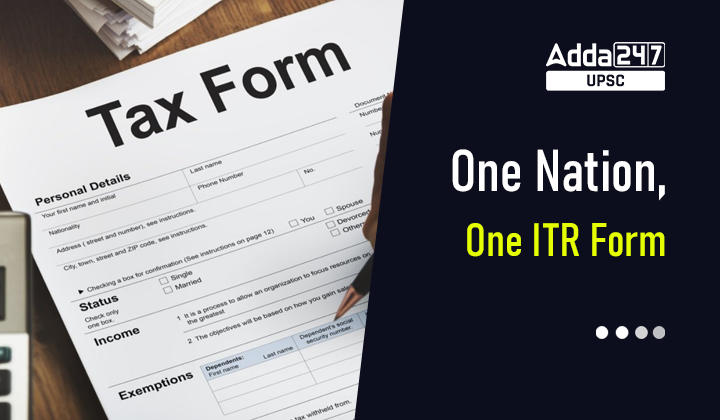Table of Contents
One Nation, One ITR Form: About One Nation, One ITR Form
One Nation, One ITR Form is a proposed simple common-income tax return (ITR) form for all taxpayers.
One Nation, One ITR Form: Relevance for UPSC
GS 3: Government Policies & Interventions, Growth & Development
One Nation, One ITR Form: Why in news?
- On November 01, the CBDT suggested creating a simple common-income tax return (ITR) form for all taxpayers.
- On the proposed new common ITR form, Central Board of Direct Taxes (CBDT) has invited stakeholder comments by 15 December.
What changes are being proposed?
- According to CBDT proposed draft ITR proposes to introduce a common ITR by merging all the existing returns of income except ITR-7.
- According to the proposal, all taxpayers, barring trusts and non-profit organizations (ITR-7), will be able to use a common ITR form, which will include a separate head for disclosure of income from virtual digital assets.
- The new ITR form would be available alongside the old forms ITR-1 and ITR-4, but taxpayers filing ITR-2, ITR-3, ITR-5 and ITR-6 would not have the option to file the old forms.
What kind of ITR forms are there now?
There are seven kinds of ITR forms, according to the categories of taxpayers. They are as follows: ITR-1It is called ‘Sahaj’, and is for small and medium taxpayers. Sahaj forms can be filed by individuals who have an income up to Rs 50 lakh, with earnings from salary, one house property/ other sources (interest etc). ITR-2It is filed by people with income from residential property. ITR-3It is intended for people who have income as profits from business/ profession ITR-4 (Sugam)Like ITR-1 (Sahaj), Sugam is a simple form, and can be filed by individuals, Hindu Undivided Families (HUFs) and firms with total income up to Rs 50 lakh from business and profession. ITR-5 and 6ITR-5 and 6 are for limited liability partnerships (LLPs) and businesses respectively. ITR-7It is filed by trusts and non-profit organizations. |
One Nation, One ITR Form: Why CBDT has Proposed new changes?
To bring best practices
- The proposed draft ITR takes a relook at the return filing system in tandem with international best practices.
- The draft form aims to make it easier to file returns, and to considerably reduce the time taken for the job by individuals and non-business-type taxpayers.
User friendly Schedules
- The taxpayers will not be required to see the schedules that do not apply to them.
- It intends the smart design of schedules in a user-friendly manner with a better arrangement, logical flow, and increased scope of pre-filling.
Proper Reconciliation
- It will also facilitate the proper reconciliation of third-party data available with the Income-Tax department vis-à-vis the data to be reported in the ITR to reduce the compliance burden on the taxpayers.
Customized ITR
- The proposed ITR form would be customized for taxpayers with applicable schedules, based on certain questions answered by them.
- Once the common ITR form is notified, after taking into account the inputs received from stakeholders, the online utility will be released by the Income Tax department.
- In such a utility, a customized ITR containing only the applicable questions and schedules will be available to the taxpayer.
One Nation, One ITR Form: Know about CBDT
1. Functions and Organization
- The Central Board of Direct Taxes is a statutory authority functioning under the Central Board of Revenue Act, 1963.
- The officials of the Board in their ex-officio capacity also function as a Division of the Ministry dealing with matters relating to levy and collection of direct taxes.
2. Historical Background of C.B.D.T.
- The Central Board of Revenue as the apex body of the Department, charged with the administration of taxes, came into existence as a result of the Central Board of Revenue Act, 1924.
- Initially the Board was in charge of both direct and indirect taxes. However, when the administration of taxes became too unwieldy for one Board to handle, the Board was split up into two, namely the Central Board of Direct Taxes and Central Board of Excise and Customs with effect from 1.1.1964.
One Nation, One ITR Form: Conclusion
The proposed new common ITR form is a step in the right direction when it comes to simplifying the return filing process particularly for individuals. It will help ease the difficulties faced in deciding which form is applicable to them.
Capex push: Proactive Tax Devolution to states



 TSPSC Group 1 Question Paper 2024, Downl...
TSPSC Group 1 Question Paper 2024, Downl...
 TSPSC Group 1 Answer key 2024 Out, Downl...
TSPSC Group 1 Answer key 2024 Out, Downl...
 UPSC Prelims 2024 Question Paper, Downlo...
UPSC Prelims 2024 Question Paper, Downlo...




